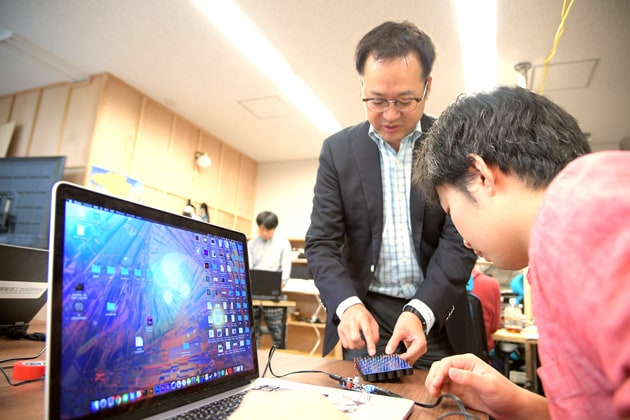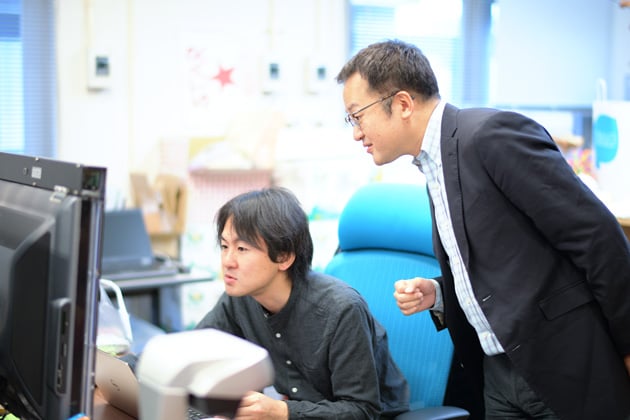
- Semiconductor Technology Now
Visiting Laboratories
Don’t cram too much knowledge before experimenting
TM: How many students do you have at your lab?
Masahiko Inami: Our lab at the University of Tokyo has four senior undergraduates assigned to us at the end of September, who are conducting research for their graduation theses. The lab is only in its second year now, so we have just three first year graduate students pursuing a master’s and two doctoral graduate students.
TM: Your research themes appear to be very complex, presumably requiring a diverse mix of insights and technologies from different areas. Given the scope of knowledge and expertise required, can the students assigned to your lab really hit the ground running?
Masahiko Inami: All of them are coping fine, in fact. It is true that research involves hard thinking and writing papers. At the same time, however, researchers should always be able to find and experience the element of play in their themes. Playing may seem irrelevant to your research, but the two are actually interwoven at some level. That’s why I encourage my students to play with a lot of toys. For instance, playing games on PlayStation VR and Nintendo Switch can give you a lot of insights and inspirations.
TM: Is there anything you pay particular attention to when tutoring your students?
Masahiko Inami: Let me think… not to let them study too much, I suppose. At the University of Tokyo or MIT or wherever, students who hit the wall in their research invariably try to look for answers in books and scientific papers. It’s true they should be thoroughly equipped with necessary knowledge, but no amount of desk study can lead them to satisfactory results. As they are at the leading edge of research, the answers they seek are simply not in the existing textbooks or papers. It is imperative that they try their hands at building concrete models and testing them.
Anything you’ve actively tried to learn will become firmly ingrained in you: I think that’s true not only for students but also for any members of the society. So, it’s important to give something a try first, figure out what needs to be learned, and then seek to acquire that knowledge. In the field of information engineering, knowledge becomes obsolete very quickly, perhaps in a matter of five years or so, and you need to keep up. What’s important is to focus sharply on the pieces of knowledge you need, and then keep learning them to solve problems. Once this strategy has become a second nature to you, it will serve you well for the rest of your life.
 |
Input consisting of diverse insights and values produces excellent output
TM: Are you conducting a lot of research in collaboration with businesses and outside research institutions?
Masahiko Inami: There are quite a few cases of such cooperation, and sometimes our students help out, too. Previously, business-academia partnerships often took the form of technology transfer, in which universities handed over their intellectual properties and inventions to businesses. In many cases, however, this model has failed to produce results. Today, the preferred model of cooperation is one in which businesses and universities work out solutions together by putting their respective challenges and skills on the table. Experience has taught them that this approach can produce much better results.
It is a great learning opportunity for students to participate in this process. They can listen to what the people in the frontier of applied research have to say, and discuss specific issues that businesses face concerning the project at hand.
TM: I assume university professors are first and foremost the seekers of academic truths. How does learning about issues that concern businesses help with their scholarly quests?
Masahiko Inami: I don’t think human brains are very different from one person to another. If you want to improve the output, the best way to do it is to change the input. For us scholars, obtaining unfamiliar information and insights from businesses means changing the quality of our input, which is essential to producing better results. I consider myself not only a researcher but an engineer as well, and as such I put great value on seeing my ideas take concrete shape and spread in society.
TM: So, getting a lot of different input is the key.
Masahiko Inami: One of the advantages of universities is that they can transcend the boundary of different industries. I’ll give you an example. When I was engaged in joint research with a construction machinery manufacturer, I realized that the concerns of my industrial partner were similar to those regularly faced by those in the game industry. That inspired me to import the know-how and approaches commonly used in the game industry to the construction machinery industry, with our lab acting as an intermediary. I imagine the partner firm had surveyed how some other companies like carmakers were handling the same problem, but I’m sure the game industry was not among their targets. This sort of match-making is a perfect role for universities.
TM: It reminds me of bees hopping from flower to flower, carrying pollens and pollinating flowers. In a sense, universities are bees that facilitate the harvest of wisdom.
Masahiko Inami: I like that analogy. Universities are not just independent institutions for education and research, but also can serve as vital nodes of society. The graduates join diverse industries, but they may work with university labs again in joint projects. That creates a connection between members of totally different industries, which might lead to some cross-industrial projects. So, the students who left the university may come back together again, just like bees from the same nest.
 |



















